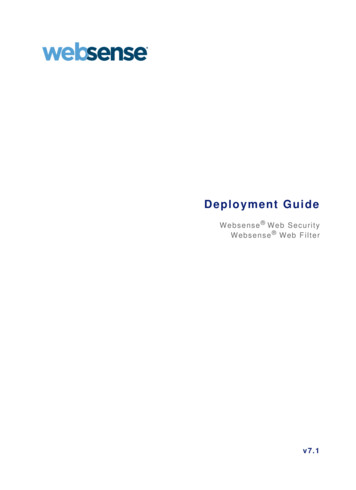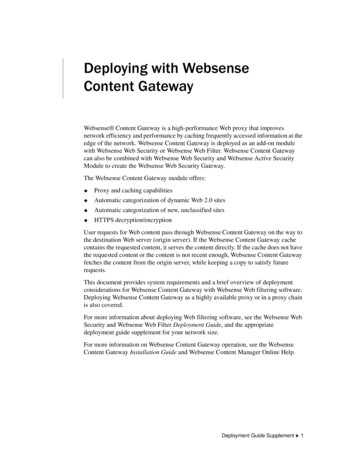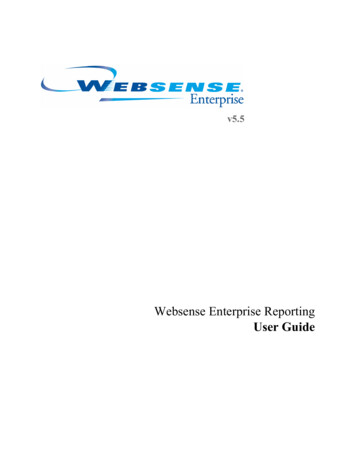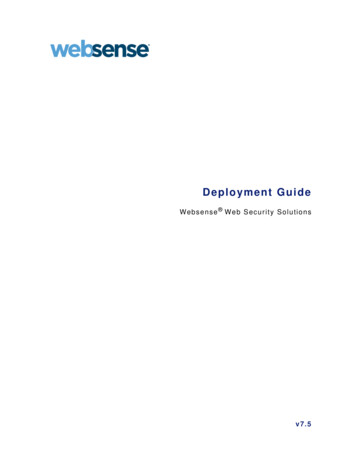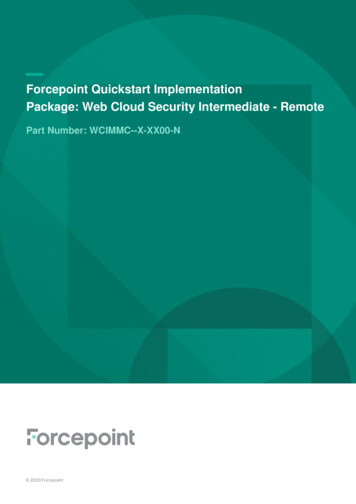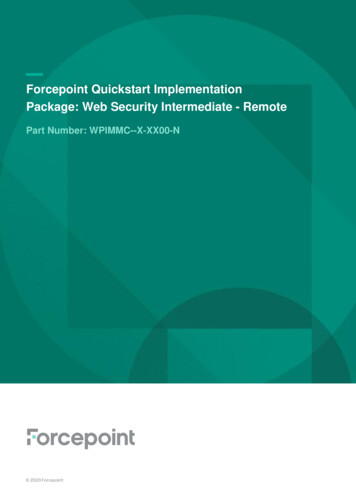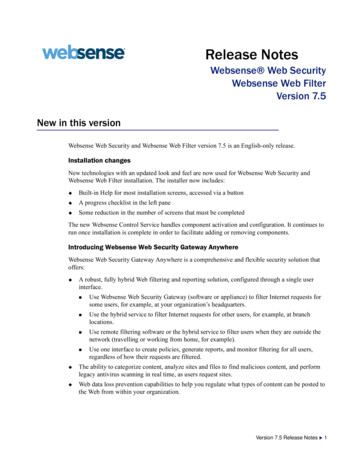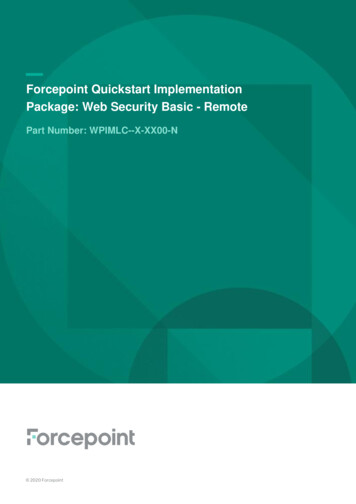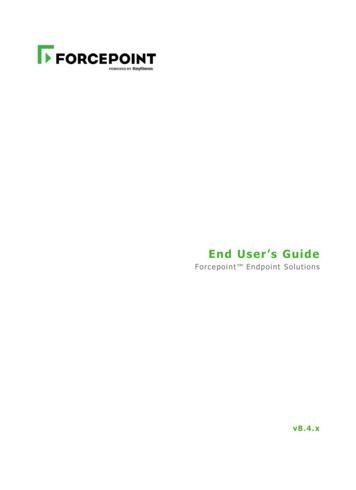
Transcription
End User’s GuideForcepoint Endpoint Solutionsv8.4.x
2017, ForcepointAll rights reserved.10900-A Stonelake Blvd., Quarry Oaks 1, Suite 350, Austin, TX 78759, USAPublished 2017Forcepoint and the FORCEPOINT logo are trademarks of Forcepoint. Raytheon is a registered trademark of Raytheon Company. All othertrademarks used in this document are the property of their respective owners.This document may not, in whole or in part, be copied, photocopied, reproduced, translated, or reduced to any electronic medium ormachine-readable form without prior consent in writing from Forcepoint. Every effort has been made to ensure the accuracy of thismanual. However, Forcepoint makes no warranties with respect to this documentation and disclaims any implied warranties ofmerchantability and fitness for a particular purpose. Forcepoint shall not be liable for any error or for incidental or consequential damagesin connection with the furnishing, performance, or use of this manual or the examples herein. The information in this documentation issubject to change without notice.
ContentsTopic 1Introduction to Forcepoint Endpoint Solutions. . . . . . . . . . . . . . . . . . . . . . . . . 3Forcepoint Web Security Endpoint . . . . . . . . . . . . . . . . . . . . . . . . . . . . . . . . . . 3Forcepoint DLP Endpoint . . . . . . . . . . . . . . . . . . . . . . . . . . . . . . . . . . . . . . . . . 3Topic 2Forcepoint Web Security Endpoint . . . . . . . . . . . . . . . . . . . . . . . . . . . . . . . . . . 5How to check the status of Forcepoint Web Security Endpoint. . . . . . . . . . . . . . . 5How to use the Forcepoint Web Security Endpoint diagnostics tool. . . . . . . . . . . 7Fallback mode . . . . . . . . . . . . . . . . . . . . . . . . . . . . . . . . . . . . . . . . . . . . . . . . . . . . 8How to view logs . . . . . . . . . . . . . . . . . . . . . . . . . . . . . . . . . . . . . . . . . . . . . . . . . . 9How to disable Forcepoint Web Security Endpoint protection . . . . . . . . . . . . . . 10Topic 3Forcepoint DLP Endpoint . . . . . . . . . . . . . . . . . . . . . . . . . . . . . . . . . . . . . . . . . 11How to check the status of Forcepoint DLP Endpoint . . . . . . . . . . . . . . . . . . . . . 11How to confirm or block a policy violation . . . . . . . . . . . . . . . . . . . . . . . . . . . . . 13How to set encryption passwords . . . . . . . . . . . . . . . . . . . . . . . . . . . . . . . . . . . . . 15Decrypting files on a removable media device . . . . . . . . . . . . . . . . . . . . . . . . 16Decrypting files on Windows . . . . . . . . . . . . . . . . . . . . . . . . . . . . . . . . . . . . . 16Decrypting files on Mac . . . . . . . . . . . . . . . . . . . . . . . . . . . . . . . . . . . . . . . . . 17How to view contained files and save them to an authorized location . . . . . . . . 18How to view logs . . . . . . . . . . . . . . . . . . . . . . . . . . . . . . . . . . . . . . . . . . . . . . . . . 19How to update Forcepoint DLP Endpoint . . . . . . . . . . . . . . . . . . . . . . . . . . . . . . 20How to disable Forcepoint DLP Endpoint . . . . . . . . . . . . . . . . . . . . . . . . . . . . . . 21Forcepoint Endpoint Solutions End User’s Guide 1
Contents2 ForcepointEndpoint Solutions
1Introduction to ForcepointEndpoint SolutionsEnd User’s Guide Endpoint Solutions Cloud and On-Premises v8.4.xYour organization uses Forcepoint endpoint solutions to protect you and other usersagainst advanced web-based threats and data theft while on and off the corporatenetwork. Endpoint solutions include server software installed on corporate servers andclient software installed on your computer.Forcepoint offers 2 endpoint solutions: Forcepoint Web Security Endpoint defends your computer against web threats. Forcepoint DLP Endpoint protects your organization from the unintended loss ofdata and data theft.If you see this iconin your task bar, Forcepoint Web Security Endpoint protectionis available and enabled.If you see this iconin your task bar, Forcepoint DLP Endpoint is protecting youand your organization.This guide covers the following:Forcepoint Web Security Endpoint How to check the status of Forcepoint Web Security Endpoint, page 5 How to use the Forcepoint Web Security Endpoint diagnostics tool, page 7 Fallback mode, page 8 How to view logs, page 9 How to disable Forcepoint Web Security Endpoint protection, page 10*Forcepoint DLP Endpoint How to check the status of Forcepoint DLP Endpoint, page 11 How to confirm or block a policy violation, page 13 How to set encryption passwords, page 15 How to view contained files and save them to an authorized location, page 18 How to view logs, page 19Forcepoint Endpoint Solutions End User’s Guide 3
Introduction to Forcepoint Endpoint Solutions How to update Forcepoint DLP Endpoint, page 20 How to disable Forcepoint DLP Endpoint, page 21**Note that disabling the endpoint introduces possible vulnerabilities, because you areno longer receiving the protection provided by Forcepoint Web Security Endpoint orForcepoint DLP Endpoint or both if both are installed and disabled.4 Forcepoint Endpoint Solutions End User’s Guide
2Forcepoint Web SecurityEndpointEnd User’s Guide Forcepoint Web Security Endpoint Cloud and On-Premises v8.4.xForcepoint Web Security Endpoint is a software application that runs on your laptopor other endpoint machine, protecting you from malware and enforcing yourorganization’s acceptable user policy.How to check the status of Forcepoint Web SecurityEndpointEnd User’s Guide Forcepoint Web Security Endpoint Cloud and On-Premises v8.4.xRelated topics: Fallback mode, page 8 How to disable Forcepoint Web Security Endpoint protection, page10 How to use the Forcepoint Web Security Endpoint diagnostics tool,page 7 How to view logs, page 9This applies to Windows operating system users. To view the status of ForcepointWeb Security Endpoint, hover over the Forcepoint icon in your task bar. Icons serve asa status indicator and an access point to additional diagnostic information:Forcepoint Endpoint Solutions End User’s Guide 5
Forcepoint Web Security EndpointIconMeaningDescriptionEnabledForcepoint Web Security Endpointsoftware is successfully configuredand activated.DisabledYou have manually disabled theendpoint software on your computer.It is no longer being protectedagainst web threats. You can reenable the software manually or itwill be enabled when your computeris restarted.The ability to enable/disableendpoint software is allocated byyour system administrator.See How to disable Forcepoint WebSecurity Endpoint protection.FallbackNetwork events prevented yourendpoint software from connectingwith cloud servers. You are nolonger being protected against webthreats. This icon displays forendpoints that go through a proxybefore connecting to the Internet.FallbackNetwork events prevented yourendpoint software from connectingwith cloud services. The systemapplies filters cached during the lastconnection to the Internet. Yourcomputer is partially protectedagainst web threats. This icondisplays for endpoints that connectdirectly to the Internet.ImportantIf you manually disable Forcepoint Web SecurityEndpoint, a reboot will always re-enable it.Note that if your organization is using both Forcepoint Web Security Endpoint andForcepoint DLP Endpoint, a Forcepoint DLP Endpoint icondisplays on your taskbar as well. For more information about Forcepoint DLP Endpoint, see ForcepointDLP Endpoint, page 11.6 Forcepoint Endpoint Solutions End User’s Guide
Forcepoint Web Security EndpointHow to use the Forcepoint Web Security Endpointdiagnostics toolEnd User’s Guide Forcepoint Web Security Endpoint Cloud and On-Premises v8.4.xRelated topics: How to check the status of Forcepoint Web Security Endpoint, page5 Fallback mode, page 8 How to disable Forcepoint Web Security Endpoint protection, page10 How to view logs, page 9This applies to Windows operating system users. Forcepoint Web Security Endpointoffers a diagnostics tool that you can access by double-clicking the Forcepoint icon inthe task bar. The tool displays information that you can provide to your systemadministrator to assist with troubleshooting if Forcepoint Web Security Endpoint isnot behaving as expected.When the tool is launched, each of the diagnostic tests is executed in sequence. If oneof the tests results in a failure, the subsequent tests are not automatically run.Three diagnostic tests are accessed from this tool:1. System information - Collects basic information related to the specificsystem on which the Forcepoint Web Security Endpoint software is installed.2. Network diagnostics - Collects information related to basic networkconnectivity.3. PAC file status - For endpoints that go through a proxy before connecting tothe Internet, collects information to determine if the PAC file is accessible.ORCloud services - For endpoints that connect directly to the Internet, collectsinformation to determine if the endpoint can contact the cloud service fordisposition information (i.e., whether to block or allow the request).To manually run the diagnostics tests, select one of the above tests and click the RunDiagnostics button.Forcepoint Endpoint Solutions End User’s Guide 7
Forcepoint Web Security EndpointNoteCorresponding log files generated from these newdiagnostics can easily be collected with the existingCLIENTINFO.EXE tool. Your Help Desk may ask youto run this tool to collect these files. To run it, click theCollect Endpoint Info. button on the diagnostics screen.The resulting file is placed onto the desktop. Attach the fileto an email to your HelpDesk or system administrator.Fallback modeEnd User’s Guide Forcepoint Web Security Endpoint Cloud and On-Premises v8.4.xRelated topics: How to check the status of Forcepoint Web Security Endpoint, page5 How to disable Forcepoint Web Security Endpoint protection, page10 How to use the Forcepoint Web Security Endpoint diagnostics tool,page 7 How to view logs, page 9Forcepoint Web Security Endpoint provides a Fallback mode if your networkconnection to the cloud service is interrupted. Events that may trigger Fallback modeinclude: Changing from Wi-Fi to an Ethernet network connection or vice-versa Connecting to a virtual private network (VPN) Assigning a new IP address to your laptop Disconnecting from the InternetWhile in Fallback mode, the Forcepoint icon displayed in your task bar changes toreflect your level of protection.If you see this iconin your task bar, your system is in Fallback mode and is notprotected against web threats. When network events prevent endpoints fromconnecting with cloud services, Forcepoint Web Security Endpoint is automaticallyand temporarily bypassed. If this happens, you can continue to access the Internet(provided Internet access is available), but endpoint protection is not provided duringthis time.If you see this iconin your task bar, your system is in Fallback mode and ispartially protected. When network events prevent endpoints from connecting with8 Forcepoint Endpoint Solutions End User’s Guide
Forcepoint Web Security Endpointcloud services, Forcepoint Web Security Endpoint applies the filter cached from thelast connection to the Internet. For example, if the user normally sees a block pagewhen visiting Facebook, then the user would also see a block page when visitingFacebook while in Fallback mode. The block page indicates that it is a result of cachedresults.Once the network issue is resolved, Forcepoint Web Security Endpoint isautomatically re-enabled.How to view logsEnd User’s Guide Forcepoint Web Security Endpoint Cloud and On-Premises v8.4.xRelated topics: How to check the status of Forcepoint Web Security Endpoint, page5 Fallback mode, page 8 How to use the Forcepoint Web Security Endpoint diagnostics tool,page 7You can see logs about system events related to Forcepoint Web Security Endpoint. Toview the logs, go to the Application section of the Windows system event log (Start Control Panel Administrative Tools Event Viewer Windows Logs Application). Examples of log notifications include: Event ID 258: “User disabled Forcepoint SaaS Service.” Event ID 257: “Forcepoint SaaS Service has entered cloud enforce mode.”These logs may be helpful to share with your system administrator. All logs are inEnglish.Forcepoint Endpoint Solutions End User’s Guide 9
Forcepoint Web Security EndpointHow to disable Forcepoint Web Security EndpointprotectionEnd User’s Guide Forcepoint Web Security Endpoint Cloud and On-Premises v8.4.xRelated topics: How to check the status of Forcepoint Web Security Endpoint, page5 Fallback mode, page 8 How to use the Forcepoint Web Security Endpoint diagnostics tool,page 7 How to view logs, page 9Disabling the Forcepoint Web Security Endpoint software removes the protectionprovided by the endpoint service, and stops it from intercepting traffic and securingyour computer from web threats. Sometimes, it may be useful to manually disable theendpoint software to troubleshoot issues with the assistance of your systemadministrator.If your organization allows you to disable Forcepoint Web Security Endpoint, whenyou right click the endpoint icon, you will see the option to Disable it. Select Disableto disable the endpoint at any time.If you see an authentication page asking for your username and logon credentials, youneed to change your proxy auto-config (PAC) file settings in Internet Explorer.Contact your system administrator for assistance with changing your PAC filesettings.To re-enable Forcepoint Web Security Endpoint, click Enable.ImportantIf you manually disable Forcepoint Web SecurityEndpoint, a reboot will always re-enable it.10 Forcepoint Endpoint Solutions End User’s Guide
3Forcepoint DLP EndpointEnd User’s Guide Forcepoint DLP Endpoint v8.4.xForcepoint DLP Endpoint (Data Loss Prevention) expands protection to sensitive informationstored on your computer. Depending on your corporate policy, data could be quarantined orencrypted when you try to email it, print it, or copy it to removable media such as thumb drives,CD/DVD burners, and Android devices. (CD/DVD and Android support depends on youroperating system.)How to check the status of Forcepoint DLP EndpointEnd User’s Guide Forcepoint DLP Endpoint v8.4.xRelated topics: How to disable Forcepoint DLP Endpoint, page 21 How to confirm or block a policy violation, page 13 How to view contained files and save them to an authorizedlocation, page 18 How to view logs, page 19 How to update Forcepoint DLP Endpoint, page 20To view status information for Forcepoint DLP Endpoint, click the Forcepoint DLP Endpoint iconon your task bar.Forcepoint Endpoint Solutions End User’s Guide 11
Forcepoint DLP EndpointOn the Forcepoint DLP Endpoint screen, you can: See whether your machine is connected to a Forcepoint DLP server. Check the IP address of the Forcepoint DLP server hosting the endpoint server software. View your endpoint profile name, and when it was last updated. Determine if Forcepoint DLP Endpoint protection is enabled or bypassed. View discovery status and details of the last and next discovery scans.Note that if your organization is using both Forcepoint Web Security Endpoint and ForcepointDLP Endpoint, a Forcepoint Web Security Endpoint icon displays on your task bar as well. Formore information about Forcepoint Web Security Endpoint, see Forcepoint Web SecurityEndpoint, page 5.12 Forcepoint Endpoint Solutions End User’s Guide
Forcepoint DLP EndpointHow to confirm or block a policy violationEnd User’s Guide Forcepoint DLP Endpoint v8.4.xRelated topics: How to check the status of Forcepoint DLP Endpoint, page 11 How to update Forcepoint DLP Endpoint, page 20 How to disable Forcepoint DLP Endpoint, page 21Occasionally, you may be asked to continue an operation that is known to be in violation ofcorporate policy. These violations are not automatically blocked by Forcepoint DLP Endpoint, andare allowed if you provide a valid explanation for the operation. If a policy violation is detected,Forcepoint DLP Endpoint displays a confirmation dialog window. From this confirmation dialog,you may choose to allow the operation to continue, or you may block the operation and cancel therequest.To continue with the action, select a Reason from the drop-down menu, and click Allow.To cancel the action, click Block to close the window.If the timer expires, the default action is taken. The default action is displayed above the timer. Forexample: Action will be blocked or Action will be permitted. The timer default is set to 30seconds, but may be changed by your system administrator to between 9 and 58 seconds.Forcepoint Endpoint Solutions End User’s Guide 13
Forcepoint DLP EndpointThe behavior of the confirmation or block action may vary depending on the action and theaffected channel: Removable Media Channel: LAN Channel: If you copy or move sensitive documents either through the Windows command line or bydragging and dropping the files through Windows Explorer to a USB drive, a writableDVD, or a mobile phone through WPD protocol, and choose the Block action in theconfirmation dialog window, Forcepoint DLP Endpoint may also block non-sensitive filesif they are copied or moved with the sensitive files.If you copy or move files to other machines mounted on the endpoint in the same localnetwork, and choose the Block action in the confirmation dialog window, Forcepoint DLPEndpoint may incorrectly state that the files were copied or moved.Web Channel: If you compose email through a web-based mail service (e.g., Gmail or Yahoo Mail), aconfirmation dialog window displays whenever the service syncs to the hosting server(i.e., when the email is auto-saved). This causes the confirmation dialog window todisplay multiple times within a short timeframe. Each sensitive attachment within an email triggers a separate confirmation dialog window. If you choose the Block action, you may receive an error message from the mail service,because the Block action interrupts the activity with the mail service.Application File Access Channel: If you choose the Block action, you may receive an error message from the application,because the Block action interrupts the activity with the application. When saving a sensitive document, you may receive multiple confirmation dialogwindows, because temporary files created by the application trigger the confirmationdialog.Email Channel: In Outlook, the Outlook process is suspended when the confirmation dialog windowdisplays. This makes it appear as if Outlook is no longer working. Once you choose eitherthe Allow or Block action, the Outlook process works as normal.14 Forcepoint Endpoint Solutions End User’s Guide
Forcepoint DLP EndpointHow to set encryption passwordsEnd User’s Guide Forcepoint DLP Endpoint v8.4.xRelated topics: How to disable Forcepoint DLP Endpoint, page 21 How to view contained files and save them to an authorizedlocation, page 18 How to view logs, page 19 How to update Forcepoint DLP Endpoint, page 20 Decrypting files on a removable media device, page 16Some corporate policies dictate that sensitive data be encrypted before being copied to aremovable media device such as a USB drive. If this is the case for your organization, you cannotcopy files to such media until you set the password to decrypt them.Set the password one time, then any time you copy sensitive data to removable media, it isencrypted and copied along with a Forcepoint Decryption Utility to the device.You, or any other user accessing the files on endpoints where the Forcepoint DLP Endpoint is notinstalled, or where the password configured for encryption is different than yours, must enter thispassword.To specify the encryption password:1. Right-click the Forcepoint DLP Endpoint icon on your task bar, and select Set EncryptionPassword.2. Enter your password, then re-enter your password.NoteThe password should be at least 8 characters in length(maximum is 15 characters), and it should contain: At least one digit At least one symbol At least one capital letter At least one lowercase letterThe following example shows a strong password: 8%w@s1*F3. Click OK.Forcepoint Endpoint Solutions End User’s Guide 15
Forcepoint DLP EndpointDecrypting files on a removable media deviceEnd User’s Guide Forcepoint DLP Endpoint v8.4.xRelated topics: How to disable Forcepoint DLP Endpoint, page 21 How to view contained files and save them to an authorizedlocation, page 18 How to view logs, page 19 How to update Forcepoint DLP Endpoint, page 20To decrypt the content on your removable media device, you must run a Forcepoint DecryptionUtility. Content that was encrypted on Windows can be decrypted on any Windows or Macmachine. (Content cannot be encrypted on Mac, however.)The Forcepoint Decryption Utility is copied to your removable media device along with theencrypted files. Decrypting files on Windows Decrypting files on MacDecrypting files on Windows1. Insert the removable device into a Windows laptop or desktop.2. Double-click Forcepoint Decryption Utility.exe or wsdecrypt.exe, depending on theForcepoint DLP Endpoint version installed:a. Forcepoint Decryption Utility.exe: Decrypts files on a Windows endpoint that does not have Forcepoint DLP Endpointinstalled.Decrypts files that were encrypted on a Windows endpoint with Forcepoint DLPEndpoint v8.4 or v8.3 installed.b. wsdecrypt.exe: Decrypts files that were encrypted on a Windows endpoint with Forcepoint DLPEndpoint v8.2.5 or lower installed.NoteIf you don’t know the Forcepoint DLP Endpoint version,open Forcepoint Decryption Utility.exe. This utility checksthe version and either decrypts the files, or openswsdecrypt.exe if the version is v8.2.5 or lower.16 Forcepoint Endpoint Solutions End User’s Guide
Forcepoint DLP Endpoint3. Enter the encryption password when prompted. A dialog appears and displays lists ofsubdirectories and files on your system.4. Navigate to the folder containing the encrypted files. By default, the files are on yourremovable media device.5. Select the folders and files to decrypt, right-click, and select Save To.6. Select the folder in which to save the decrypted files.Decrypting files on Mac1. Insert the removable device into a Mac laptop or desktop.2. Double-click Forcepoint Decryption Utility.dmg and mount it as a disk volume.3. Launch the application Forcepoint Decryption Utility in the disk volume.4. Drag and drop the encrypted files from the removable media device into the application’s listwindow.Forcepoint Endpoint Solutions End User’s Guide 17
Forcepoint DLP Endpoint5. Select the file to decrypt, and select Decrypt File As. If the file selected is not encrypted byForcepoint DLP Endpoint, the operation is disabled.6. Enter the encryption password when prompted. A file save dialog appears if the correctpassword is entered.7. Enter the file name that you want to save the decrypted file as.8. If necessary, select the next file to decrypt. No prompt appears as long as it is encrypted by thesame password.The Forcepoint Decryption Utility decrypts the files using the password you provided and placesthem in this path.Files that were encrypted with a different password are not decrypted.How to view contained files and save them to anauthorized locationEnd User’s Guide Forcepoint DLP Endpoint v8.4.xContained files are those that are held in temporary storage on an endpoint machine.Files are contained if your organization chose to prevent sensitive information from being writtenfrom an endpoint machine to a removable device—such as a USB flash drive, CD/DVD, orexternal hard disk—and you try to copy a file to an unauthorized device. If the file has beenmodified, the contained file will include these modifications, while removing the modified filefrom the unauthorized device.18 Forcepoint Endpoint Solutions End User’s Guide
Forcepoint DLP EndpointYou can view the contents of contained files from the endpoint machine, and choose to save themto an authorized location instead.1. On the Forcepoint DLP Endpoint screen, click Contained Files.2. To see the contents of a file, select the file and click Open.3. To save a file to an authorized location, select the file and click Save As, then browse to thenew location.4. Click Close when done.How to view logsEnd User’s Guide Forcepoint DLP Endpoint v8.4.xRelated topics: How to disable Forcepoint DLP Endpoint, page 21 How to view contained files and save them to an authorizedlocation, page 18 How to view logs, page 19 How to update Forcepoint DLP Endpoint, page 20There are two logs available in Forcepoint DLP Endpoint: The System Log contains information about changes on your machine. For example: Changes of connection status, such as your computer moving from an office to a remotelocation When Forcepoint DLP Endpoint is enabled or disabled When Forcepoint DLP Endpoint profiles are applied and updated When the client is connected to or disconnected from the Forcepoint DLP Endpoint serverForcepoint Endpoint Solutions End User’s Guide 19
Forcepoint DLP Endpoint The Content Log contains details of file operations that have been picked up by the endpointpolicy, and any actions taken by Forcepoint DLP Endpoint as a result.To see the log details, on the Forcepoint DLP Endpoint screen, click View Log.To see the latest log information, click Refresh.How to update Forcepoint DLP EndpointEnd User’s Guide Forcepoint DLP Endpoint v8.4.xRelated topics: How to disable Forcepoint DLP Endpoint, page 21 How to view contained files and save them to an authorizedlocation, page 18 How to view logs, page 19 How to update Forcepoint DLP Endpoint, page 20Periodically, your corporate policies and Forcepoint DLP Endpoint profile are pushed to yourmachine to keep them up to date. To update them manually, click Update on the Forcepoint DLPEndpoint screen.20 Forcepoint Endpoint Solutions End User’s Guide
Forcepoint DLP EndpointHow to disable Forcepoint DLP EndpointEnd User’s Guide Forcepoint DLP Endpoint v8.4.x1. On the Forcepoint DLP Endpoint screen, click Disable.2. Report the bypass ID to your Forcepoint DLP administrator.3. Enter the bypass code supplied by the administrator.4. Click Enter.The endpoint client is disabled for the length of time specified when the bypass code was created.The Disable iconon the task bar updates to the Default iconwhen the bypass protectionexpires.@2017 ForcepointForcepoint Endpoint Solutions End User’s Guide 21
Forcepoint DLP Endpoint22 Forcepoint Endpoint Solutions End User’s Guide
How to disable Forcepoint Web Security Endpoint protection End User's Guide Forcepoint Web Security Endpoint Cloud and On-Premises v8.4.x Disabling the Forcepoint Web Security Endpoint software removes the protection provided by the endpoint service, and stops it from intercepting traffic and securing your computer from web threats.
